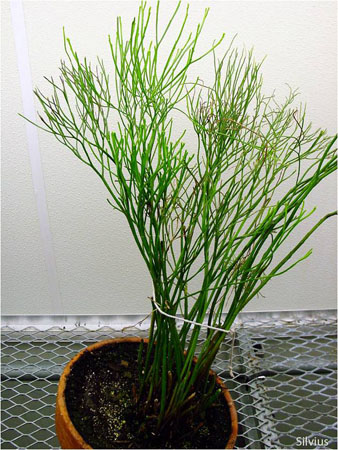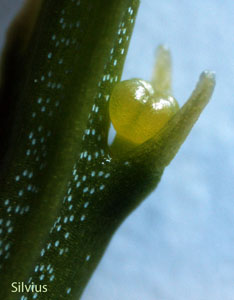
Psilotum nudum with apparent dichotomous branching

Synangium of Psilotum nudum with forked sporophylls

Psilotum is adapted to a rupestral habitat as shown here
near the Sidney Opera House, Sidney, Australia
Psilotum Project
Research on the Whisk Fern Family (Psilotaceae)
Page in Progress
Brief Background:
The whisk fern family (Psilotaceae) consists of two genera, Psilotum (photos left) and Temesipteris, neither of which appear in the fossil record. Therefore, the family Psilotaceae continues to perplex biologists who seek to understand the origin of these rootless and seedless vascular plants.
Early Proposals:
> Psilotum is a primitive survivor of the extinct, leafless, rootless rhyniophytes (Eames, 1936; and Gifford & Foster, 1989).
> Psilotum is a ‘fern’ similar to Stromatopteris based on the claim by Bierhorst (1977) that both have a unique, primitive shoot system.
Recent Claims and Results:
> Plant morphologists must begin with emphaisis on relationships at the organismic and organ levels to determine origins (Kaplan, 1977,2001).
> Molecular sequence analysis produced different topologies than morphological character analysis (Schneider, et al. 2009)
Rationale for Our Research:
> Fossil evidence for a phylogenetic origin of Psilotaceae is lacking
> Character similarities between taxa do not assure homology
> Phenetic approaches can be used to determine dissimilarity (discontinuity) between taxa-- e.g. phenetic (or baraminological) distance (Robinson and Cavanaugh, 1998).
> We utilized a phenetic analysis of character matrices to determine the degree of dissimilarity between Psilotaceae and allegedly related taxa
(Wood, 2005).
Purpose, Methods, Results -- See Links below

Daniel Thomas studies morphology of Psilotum nudum.
Related Web Sites:
Research Poster for "Botany 2010" Botanical Society of America, Providence, RI
References for BSA Poster
YouTube Short Presentation at "Botany 2010"
Great Images of Psilotaceae and Other Monilophytes